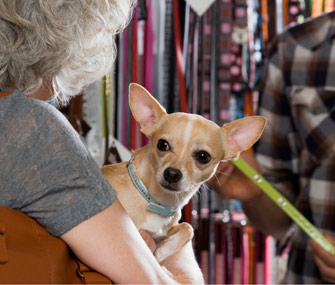Bad Weather Blues: How to Keep You and Your Dog From Going Stir Crazy
by Liz Ozaist
Published on March 01, 2015

It’s pouring — again. Or it’s snowing — again. Or it’s 95 degrees in the shade and too hot for man or beast to be outdoors.
Regardless of the meteorological predicament outside, it’s the same story inside: There you and your dog sit, both feeling stir crazy. As for you, well, you just can’t watch one more movie on Netflix — or play one more round of fetch.
Instead of suffering, you should prepare for the inevitable bad weather with adventures that you can enjoy at the spur of the moment as well as those that are longer term solutions. Of course, be sure to talk to your vet to see what exercises and activities she thinks your dog should try — and avoid.
1. Hit Up Favorite Shopping Spots
It may not seem like much of an adventure to you, but taking your pup along with you to run errands at the local pet shop or dog-friendly store can feel like a great, big adventure to him if he enjoys meeting new people.
Mikkel Becker, a certified dog and cat trainer, agrees, noting that these seemingly everyday jaunts can actually help fine-tune your pup’s socialization skills — at any age. “Socialization is essential for helping your dog feel comfortable with different aspects of life he may encounter, including other people,” she explains. “And it should be done throughout his life to continue building positive associations.”
To make the experience even more enriching, pack some of your pup’s favorite treats. When you come across friendly store employees, they can offer rewards to your dog for doing things like sitting on command. Your pup will have a positive social experience — and you’ll check something off your to-do list.
2. Take an Exercise Class — Together
If you’re the type who loves to hike, swim and run with your dog in tow, foul weather can really put a damper on your mood — and motivation.
But, across the country, there are indoor fitness classes offered for dogs and their parents, including doga (yes, that would be doggy yoga) and even freestyle musical dance — agile canines learn such nifty tricks as properly bowing before a waltz. If you are serious about dancing with your pooch, check out sites like The World Canine Freestyle Organization and the Musical Dog Sport Association.
And while you’re doing that research, Becker says you should keep a few things in mind when considering a doggy fitness class. “Look for one that uses positive reinforcement, with primarily reward-based tactics,” she says. “Even in positive classes, there can be very mild punishers, such as ignoring the dog or a mini timeout, which can heighten anxiety.”
3. Sign Up for Indoor Agility Classes
A-frames, tunnels and weave poles are just some of the track-and-field-style obstacles your dog will be tackling in an agility class — with you acting as his guide. This is the Cadillac of canine fitness options because it works all of your pup’s muscle groups, including the mind.
“Agility provides a common language, and with that language, it’s easier to communicate in a manner that feels rewarding to both the dog and person,” says Becker. “The feeling of looking for the good in your dog, and rewarding the good you do see, feels great. It also feels good to the dog, who’s free to express himself.”
Once your pup has passed a basic obedience class — often a prerequisite for agility courses — you can enroll him in a six-week class. For more information, check out The United States Dog Agility Association and the American Kennel Club, and talk to your veterinarian about classes in your area.
Not quite ready to hit the ground, ahem, running? Ask your vet to recommend a more elementary clicker-based trick training class, which will get your dog up to speed on “crawl,” “high five” and “take a bow.”
4. Get Involved in Animal-Assisted Activities
Who’s a good boy? Your dog — when you get him certified to participate in such animal-assisted activities as visiting the elderly at nursing homes or playing with kids living in long-term care facilities.
To learn more about getting involved in animal-assisted activities, read the Vetstreet article “The Making of a Therapy Dog” or visit Therapy Dogs International or Pet Partners. Bonus: It will do your heart some good, too.
5. Schedule Some Yappy Time
Let’s face it. Sometimes you just need to chill, but that doesn’t mean you have to sequester yourself on the couch with a pint of gelato.
For a low-impact adventure (for you, that is), consider teaming up with fellow dog owners to host rotating, at-home play dates. Or call a doggy daycare in your area to see if they host regular yappy hours, when dogs can let loose in a large play area while their parents sit back with a latte and watch.
More on Vetstreet:
- How to Keep Your Dog Happy in Winter
- What’s Going On When You Talk to Your Pet
- Why Does My Dog… Look Guilty?
- How Exercising With Your Dog Helps You Both
- 8 Wineries That Have Gone to the Dogs





